Montferrat
This article includes a list ofgeneral references,butit lacks sufficient correspondinginline citations.(August 2021) |
This articleneeds additional citations forverification.(August 2021) |
| UNESCO World Heritage Site | |
|---|---|
 | |
| Location | Italy |
| Part of | Vineyard Landscape of Piedmont: Langhe-Roero and Monferrato |
| Criteria | Cultural: iii, v |
| Reference | 1390rev-006 |
| Inscription | 2014 (38thSession) |
| Area | 2,561 ha |
| Buffer zone | 16,943 ha |
| Coordinates | 45°3′3″N8°23′23″E/ 45.05083°N 8.38972°E |

Montferrat(UK:/ˌmɒntfəˈræt/MONT-fə-RAT,[1]US:/-ˈrɑːt/-RAHT;[2]Italian:Monferrato[moɱferˈraːto];Piedmontese:Monfrà,locally[mʊŋˈfrɒ];Latin:Mons Ferratus) is a historical region ofPiedmont,in northern Italy. It comprises roughly (and its extent has varied over time) the modern provinces ofAlessandriaandAsti.Montferrat is one of the most important wine districts of Italy. It also has a strong literary tradition, including the 18th century Asti-born poet and dramatistVittorio Alfieriand the AlessandrianUmberto Eco.
The territory is cut in two by the riverTanaro.The northern part (theBasso Monferrato,"Low Montferrat" ), which lies between that river and thePo,is an area of rolling hills and plains. The southern part (theAlto Monferrato,"High Montferrat" ) rises from the banks of the Tanaro into the mountains of theApenninesand thewater dividebetween Piedmont andLiguria.
On 22 June 2014, Montferrat was declared a UNESCO World Heritage Site.[3]
History
[edit]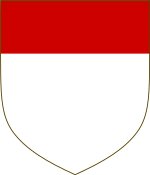

Originally a county, it was elevated to amargravateof theHoly Roman Empireunder CountAleramoin 961, following the transition of power in northern Italy fromBerengar of IvreatoOtto I of Germany.Itsmarchesi(marquesses) and their family members were related to theKings of Franceand theHoly Roman Emperors.Members of the family participated frequently in theCrusades,and intermarried with the royal family ofJerusalemand theByzantineImperial families ofComnenus,AngelusandPalaeologus.TheMarch of Montferratwas briefly controlled bySpain(1533–1536) before it passed to theGonzagaDukes of Mantua(1536–1708). In 1574, Montferrat was raised to aDuchybyMaximilian II, Holy Roman Emperor.With theWar of the Mantuan Succession(1628–1631) a piece of the duchy passed to theDuchy of Savoy,the remainder passing to Savoy in 1708, asLeopold I, Holy Roman Emperorgained possession of the Gonzaga territory. The next heir of theHouse of Gonzagawas later compensated by givingDuchy of TescheninSilesiato them.

Etymology
[edit]There are various interpretations and assumptions concerning the etymology ofMontferrat,but to date none are certain. There are many opinions, with Aldo Ricaldone stating the name was derived from "Mount" andfarro— a variety of wheat. Another claim is that it comes from the LatinMons feraxmeaning "fertile and rich mountain". Still another refers to the irons (Latinferrus) left by the Romans in their conquest,Mons ferratus.Finally, an interpretation derived from a legend according to whichAleramo of Montferrat,the legendary founder of its march, wanting to shoe a horse, and not finding a hammer, used a brick (monin the local dialect of Piedmontese), and thereby the horse was shod (fra,deriving from the sameferratusmentioned above), hence the nameMonfràyieldingMontferrat.
Geography
[edit]
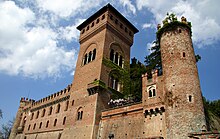

Montferrat can be divided into three main parts:
- Basso Monferrato(low Montferrat) or Casalese is characterized by its soft hills, to the exclusion of the Sacred Mount of Crea (455 m) (Unesco World Heritage), never reach heights of over 400 meters; territorially includes part of the province of Alessandria consisting of the countryside near Casale Monferrato. It is bounded on the north and east by the rivers Po and Tanaro.
- Monferrato Astigiano(Astesan Montferrat): Identifies virtually the entire Province of Asti (with the exception of Langa Astigiana) and is characterized by a hilly conformation and several historic towns such Nizza Monferrato, Cortanze, Cocconato, Montiglio and Canelli. Asti is the geographical heart of this macro-region, bordered on the south by the valley of the river Belbo and west roughly from the path of the stream Versa and whose right side Asti is located. The highest point of the area is the hill of Albugnano of 549 meters above sea level.
- Alto Monferrato(high Montferrat): extending south from the Val Bormida up to lick the foot of the Ligurian region, is bounded to the west by the valley of the Bormida Spigno and east by the western portion of the middle valley Scrivia. The main centre is Acqui Terme.
Geology
[edit]

20 million years ago the Alps were formed, in the Mediterranean area was produced a new rising heat from the Earth's mantle which resulted in the buckle and rupture of the European crust from which detached the Sardinian-Course block, the micro Sardinian plate did pin on the Ligurian Gulf executing a counterclockwise rotation of 50° and forming the Ligurian Sea. The sea covered the hill ofTurin,theLanghe,Montferrat and the Po Valley. The rotation of the Corsica-Sardinia block opposed by the African block produced a pressure that gave rise to the Apennines. 8 million years ago to the east of the Corsica-Sardinia block opened a wide north–south divide that separated the Italian peninsula from Corsica and Sardinia, this gap widened to become the Tyrrhenian Sea. In the period from 7 to 5 million years ago, the Mediterranean Sea was closed and remained isolated from the Atlantic Ocean. This resulted in the increase of the temperature of the water that turned the Mediterranean into a low-salt lake with many areas dried up, this condition lasted for several hundreds of thousands of years was deposited sediment type saline evaporites. Subsequently, the Mediterranean Sea was opened, and the ocean water began to circulate between the Alps and the Apennines had formed a triangular gulf that covered the entire Po Valley. Due to the continuous lifting of the Alps and the Apennines to the sea withdrew from this gulf and the accumulation of sediments carried by the rivers gave rise to a flood plain which corresponds to the Po Valley. The marine deposits of this period are visible in the area ofAsti.
Economy
[edit]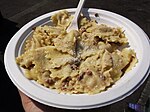
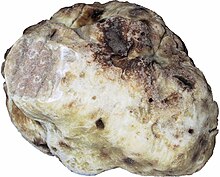
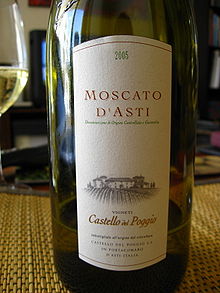
Monferrato is one of the most famous Italian wine regions in the world, especially regarding red wines and sparkling wines. The climate is dry continental with hot summers prone to drought and cold winters and the particular hydrogeological soil are favourable for viticulture, which, however, is dominant throughout, making the wine not only an element of economic wealth for the entire region but also a true symbol of the culture and tradition "Monferrina". The widespread dissemination of indigenous grapes and consequently a wide variety of wines, witness them. Among the wines (DOC andDOCG), the most famous areBarbera d'Asti,Asti spumante,Moscato d'Asti,Cortese,Malvasia,andGrignolino.
The Monferrato, together withAlba,is also known for the production of truffles; there are many fairs in this trade, for example, the regional fair of truffles held inMontechiaro d'Asti.
Viticulture
[edit]DOCandDOCGwines produced in this area include:
Reds
[edit]- Barbera d'Asti
- Barbera d'Asti Superiore
- Nizza DOCG(fromBarberagrapes)
- Barbera del Monferrato
- Monferrato Rosso
- Ruché
- Albugnano (fromNebbiolograpes)
- Dolcetto d’Asti
- Freisa d’Asti
- Grignolino
- Malvasia di Casorzo
- Malvasia di Castelnuovo Don Bosco
- Dolcetto di Ovada
Whites
[edit]- Moscato d'Asti
- Asti Spumante
- Cortese dell’Alto Monferrato (fromCortesegrape)
- Loazzolo (wine)
Culture
[edit]
Cuisine
[edit]The traditional cuisine of Montferrat, in addition to the award-winning wines, includes a wide variety of foods ranging from meat, fish, vegetables, and cheeses. Typical Monferrato dishes, which have now achieved a reputation not only nationally but also internationally include, among the first courses,agnolotti"al plin" (literally "pinched" ), "Tajarin" (noodles for rich eggs seasoned with various sauces), risotto of Casale, rice with mushrooms and red wine, vegetable soups,polentawith fried cod or "loan". Worthy of mention and especially well known isBagna càuda.Among the meats: tripe, paws (batciuà), chickpeas with head, oxtail (now cooked with Barbera) and the cooked sausage.
Literature
[edit]In the second half of the 15th century stands in the field of dialect literature Gian Giorgio Allioni of Asti, poet, playwright and writer who knowing poetry in French and Italian, wrote several farces in dialect, expressing "an Astezan" and providing a vivid picture of customs and life of the period and the Italian theatre of the 16th century, often steeped in satire and mockery. It was not until the 18th century to find two other versifiers Monferrato dialect that is the prior Incisa and Captain Joseph Stefano della Rocca, while in more recent times and in the 19th century that stands out the most famous Angelo Brofferio, politician, journalist and deputy linked to the Risorgimento, who wrote songs in dialect, plays and works of history.
Art
[edit]
Artists active in the Montferrat include Gian Martino Spanzotti of Casale andAndrea Pozzo,Renaissance painter and architect active in the 17th century, the painterPier Francesco Guala;Macrino d'Alba,a contemporary of Spanzotti, whose works are in private and public collections in the United States and Turin. His most important works can, however, identify a triptych housed in the castle of Camino, aMadonna Enthronedkept in the Sanctuary of theSacro Monte di Crea,anotherMadonnain the church of St. John the Baptist to Alba and aMarriage of St. Catherinethat adorns the church of Neviglie in the Langhe.Guglielmo Caccia,nicknamed "The Moncalvo", executed works such as a "Redeemer" statue from Museum of Asti and "Resurrection" in the cathedral; several of his paintings can be found in the parishes of Grazzano Badoglio, Villadeati, Casale Monferrato, San Salvatore Monferrato, Moncalvo and Castagnito.
Architecture
[edit]The architecture flourished in Montferrat from the year 1000 onwards and is clearly visible in the numerous buildings, churches, castles and palaces of various periods many of which are still well preserved. Architecture was influenced by current Romanesque, Gothic and Renaissance trends, before becoming, from the 17th century onwards, a current of Piedmontese Baroque. Architects who worked in Montferrat includeBenedetto Alfieri(1707-1767) of Asti, considered the successor toFilippo Juvarra,and Francesco Gallo (1672-1750) of Mondovì, as well asFrancesco Ottavio Magnocavalli,born in Casale Monferrato.

Sacred Mount of Crea
[edit]TheSacred Mountain of Crea(Italian:Sacro Monte di Crea) is aRoman Catholicsanctuary in thecomuneofSerralunga di Crea(Montferrat), nearAlessandria.It is one of the nineSacri Monti of Piedmont and Lombardy,included inUNESCO World Heritagelist.
Its construction was begun in 1589, around a former Sanctuary of St. Mary whose creation is traditionally attributed toSt. Eusebius,who first Christianized the site around 350 AD.
See also
[edit]- Rulers of Montferrat,for a full list of marquesses and dukes
- March of Montferrat
- Duchy of Montferrat
- Iudiciaria Torrensis
References
[edit]- ^Jones, Daniel(1924).An English Pronouncing Dictionary(2nd ed.). London: Dent.
- ^"Montferrat".The American Heritage Dictionary of the English Language(5th ed.). HarperCollins.Retrieved18 May2019.
- ^CNN - UNESCO's newest World Heritage sites
Sources
[edit]- Official web site for European Sacred Mounts
- Money in the Montferrat from Medieval to Modern Times (italian/english)
External links
[edit]- Monferrato Expo 2015
- Basso Monferrato Tourist Board
- Alto Monferrato Tourist Board
- Monferrato's wines
- .Encyclopædia Britannica.Vol. XVI (9th ed.). 1883. p. 738.
- Sacro Monte di Crea
- Communities of hills between Langhe and Monferrato
- MonferratoArte(in Italian)A historical and bibliographical directory of artists active in the extra-urban Churches of the Diocese of Casale Monferrato.
- Official UNESCO photo selection
- Complete UNESCO photo gallery before selection

